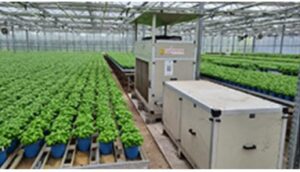DryGair Dehumidifiers - the Energy Saver

Total Humidity Control 
DryGair dehumidifiers allows a grower to close greenhouse vents to achieve optimum indoor humidity control. By closing the vents and windows, one can retain heat and reduce heating requirements, allowing for full control over the greenhouse climate.
Minimize Energy Loss.
DryGair allows growers to completely control humidity
without any air exchange. It creates the perfect
environment for plant growth and disease prevention while
significantly reducing energy loss. The DryGair solution is
proven to save up to 70% on greenhouse energy costs.
How DryGair Saves Energy 
With DryGair in the growing facility, you can keep the vents, windows and screens closed during the night or on humid or cold days and treat humidity from inside. This lets you avoid unnecessary heat loss and retain all the heat from your heating system. In comparison to heating and venting, insulating the greenhouse and using DryGair to control humidity during the night can save as much as 70% on energy in all crops.
Energy Saving Study
Basil Greenhouses, Germany; 57% average energy savings 1.9 years (23 months) ROI

One of our growers has conducted a study in their basil greenhouses in Germany, comparing energy consumption between greenhouses using DryGair, and control greenhouses, using heating and ventilation. The study spanned 3 seasons – spring, summer, and autumn, and resulted in accumulative energy savings of 100 kW per m2 of greenhouse space. On average, greenhouses using DryGair saved 57% on energy, compared to the control greenhouses. The ROI on energy savings alone amounted to only 1.9 years (excluding revenue increase due to higher quality crops, larger yields, etc.).
Humidity Control
DryGair vs. Traditional Controls
The Problem with Heating and Venting
Traditional greenhouse humidity reduction methods include a mixture of:
• Ventilation – removes humid air by releasing it from the space, creating an exchange of air with the outdoors.
• Heating – reduces relative humidity by increasing the air’s capacity to hold moisture.
These methods may be effective and should be used whenever outdoor conditions allow it; i.e. when temperatures and relative humidity are comfortable and do not negatively impact the greenhouse climate. But, attempting to control humidity using ventilation when outside conditions aren’t favorable will result in massive heat loss, requiring reheating to maintain comfortable temperatures. This creates an inefficient cycle. Heat is constantly lost to the environment, while heating systems continue to operate, leading to substantial wasted energy.
